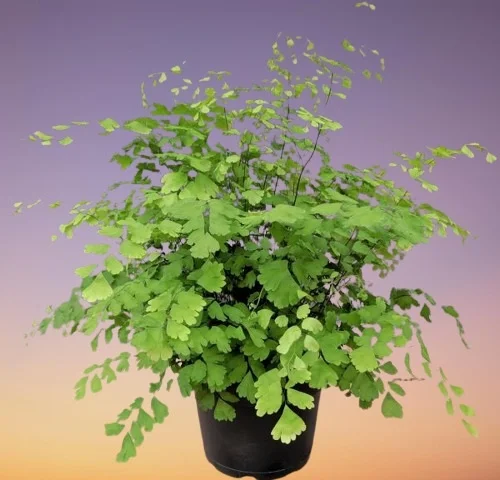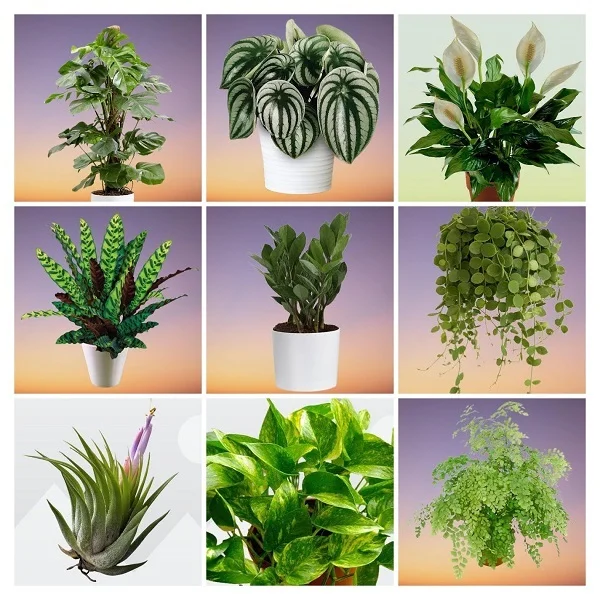How to Care for Adiantum Maidenhair Fern Indoors
Some links in this post may be affiliate links
Adiantum Maidenhair Fern grows best in a brightly lit spot with plenty of humidity and warmth and consistently moist, rich, well-drained soil coupled with monthly feeding in the growing season.
Adiantum raddianum also called Delta Maidenhair Fern is among the popular fern plants and bears wiry, shiny, dark stems which resemble human hair, hence the common name.
The fronds in Maidenhair Fern are semi-erect in young plants but they droop as the plant ages making it perfect for a hanging basket. The fronds are small and have a lace-like appearance.
Delta Maidenhair Ferns have a delicate constitution requiring moist air, warmth and bright indirect light which makes them some of the best plants for a closed terrarium.
The genus name is derived from the Greek word adiantos, meaning "unwetted" in reference to the leaves ability to repel water without being wetted.

Botanical name: Adiantum raddianum
Synonmy: Adiantum cuneatum
Family: Pteridaceae
Common names: Maidenhair Fern, Delta Maidenhair Fern
Origin
Adiantum raddianum also called Adiantum cuneatum is native to North America where they can be found growing on rocks and in between rocks around waterfalls where moisture seeping through sustains them.
How big can Maidenhair Fern get?
Maidenhair Fern can grow to a height of 2 feet with a spread of 1-2 feet.
Is Maidenhair Fern toxic?
Maidenhair Ferns are non-toxic to humans and pets. They are safe to grow in a home with cats, dogs and other pets.
Where to Buy
Maidenhair Fern is a valuable addition to any plant collection, you may acquire these ferns online from Etsy (Link to Etsy) or from Amazon Link to Amazon).
Maidenhair Fern Indoor Care
To care for Maidenhair Fern indoors, give it bright indirect light, warmth of 18-250C, humidity of 70-80% and consistently moist, fertile, well-drained soil coupled with monthly feeding during the growing season.
Adiantum Maidenhair Fern also requires frequent pruning to maintain it neat as well as discourage pest infestations. Repotting is necessary when the fern becomes pot-bound as failure to repot in time may result in wilting and death of the fern. Keep reading for more on these growing conditions and how to achieve them.

Watering
How often should I water Maidenhair Fern?
For optimum growth, water your Maidenhair Fern liberally in spring and summer while allowing the top 1-2 inches of soil to dry out between waterings. Keep the soil consistently moist but avoid overwatering to prevent yellowing, rotting and leaf drop.
Decrease watering in fall and winter as growth is minimal at this time but do not let the soil dry out completely to avoid wilting, yellowing and leaf fall.
Use room temperature water to prevent cold shock which can lead to reduced growth, leaf drop and plant death. To avoid browning of leaf edges, use chlorine free water like rain water or filtered water.
Ensure the pot has a drainage hole and the soil is free-draining to prevent the soil from getting soggy as it can result in root-rot and death of the fern.
Light Requirements
Where is the best place to put a Maidenhair Fern?
Place your Maidenhair Fern in bright indirect light (filtered light) away from direct sunlight to prevent scorching of the fronds.
If the light is too low for Delta Maidenhair Fern it will begin to turn yellow and the stems become elongated. To avoid these, you may grow the fern under grow lights where the natural light is not adequate.
Turn the pot regularly to ensure that the fern receives light on all sides for even growth and to prevent leggy growth.
Temperature and Humidity
Average warmth of 18-250C is ideal for Maidenhair Fern. A room temperature that is comfortable for you is ideal for this plant. Keep it away from drafts as it requires consistent warmth. Drafts cause sudden changes in temperature which can result in stunted growth and leaf drop.
Delta Maidenhair Fern requires a high humidity of 70-80% to thrive. Too little moisture will lead to curled leaves, brown leaf tips and edges and leaf drop. It is important to maintain the air moist at all times.
To raise humidity for the fern, set the pot on a wet pebble tray, use a cool mist humidifier or group the plants together. Maintain proper air flow for the plant to reduce fungal diseases infestations.
You may also grow the fern in a well-lit bathroom, kitchen, laundry area and other moist areas in the home. Maidenhair Fern is one of the best plants for the bathroom; perfect for absorbing moisture and cleaning the air.
Do not mist your Maidenhair Fern and avoid wetting the foliage as it encourages infestation by fungal diseases. Keep the foliage as dry as possible; if you happen to wet the foliage, you may use a soft cloth to dry.
Potting Mix
What is the best potting mix for Maidenhair Fern?
The best potting mix for Maidenhair Fern is a neutral to slightly alkaline (Ph 7-8), loose, well-draining mix that is rich in organic matter. Avoid heavy compact soils to prevent waterlogging which can lead to death of the fern. A potting mix comprising of 1 part potting soil, 1 part peat and 1 part compost is ideal for this plant.
Fertilizer
Feed your Maidenhair Fern with a liquid fertilizer (foliar feed) once a month in spring and summer for a lush growth. Avoid too much fertilizer as the fern is not a heavy feeder.
Stop feeding in fall and winter to avoid fertilizer burn as growth is reduced at this time. In addition, avoid Nitrogen-rich fertilizer as it can result in brown leaf tips.
Pruning
Pruning Maidenhair involves removal of dead and damaged fronds; as the fern ages, the older fronds turn brown. Cut them off at the base to maintain the fern looking neat and tidy as well as reduce pest and diseases infestations.
Repotting
When to repot a Maidenhair Fern?
Repot your Maidenhair Fern at the beginning of the growing season (spring to early summer) when it becomes extremely overcrowded; Maidenhair Fern prefers to be slightly pot-bound.
One sign of an overcrowded fern is wilting leaves and slow growth. Failure to repot an overcrowded fern can result in death of the plant. Repotting Maidenhair Fern every 1-2 years is adequate for this fern.
How to repot a Maidenhair Fern?
- At least one day before repotting, water the fern thoroughly to hasten establishment.
- Select a pot that is 1 size larger than the current one that has a drainage hole to prevent rotting. Take a look at these ceramic pots with a drainage hole on Amazon.
- Fill the pot one third way with free-draining soil to avoid waterlogging which can lead to death of the fern.
- Remove the fern from its pot, brush off excess soil from the roots and cut away any dead roots.
- Carefully place the fern in the center of the pot, continue to fill the pot while firming the soil around the roots.
- Wet the soil thoroughly and replace the fern to its usual place and carry on with routine care.
Note: You may also divide a large fern into several sections which can then be potted individually to propagate new ferns (see below under the section "propagation").
Adiantum Maidenhair Fern Propagation
How do you propagate Maidenhair Ferns?
Maidenhair Ferns are propagated from spores or by plant division at the beginning of the growing season (spring to early summer) when in active growth.
1. Maidenhair Fern propagation by plant division
- One day before division, thoroughly water the fern to make it easier to divide as well as hasten establishment.
- Gently slip the fern out of its pot, brush off excess soil from the roots and cut away any dead roots.
- With a clean, sharp pair of scissors divide the fern into several sections. Ensure each section has adequate roots.
- Select small pots which have a drainage hole to prevent the soil from getting soggy to avoid rotting.
- Fill the pots one third way with free-draining soil and moisten it slightly.
- Carefully place each section in the center of the pot, continue to fill the pot while firming the soil around the roots.
- Place the pots in a warm, well-lit place away from direct sunlight to avoid sunscorching.
- Maintain the soil moist through out until the new ferns are well established after which you can begin routine care.
2. Maidenhair Fern propagation from spores
- Spores are brown dots on the underside of the fronds of your Maidehair Fern. When they ripen, the cases open and tiny dust-like spores fall out.
- Cut the frond and place it on a piece of paper with spores side down.
- Allow time for the spores to fall out of the cases onto the piece of paper. The spores can also be obtained by shaking the frond occasionally.
- Thinly spread the spores on moist soil and cover the set up with clear polythene to maintain humidity and warmth.
- Place the set up in a brightly lit area away from direct sunlight. The spores should sprout in 1-2 months.
- Allow the new ferns to be well established before transplanting after which you can begin routine care.

Adiantum Maidenhair Fern Problems & Solutions
Maidenhair Fern problems include yellowing leaves, leaf drop, wilting leaves, brown leaf tips and edges, pests and diseases among others. Keep reading for more on these problems and how to fix them.
Yellowing leaves
The main causes of yellow leaves on Maidenhair Fern are too little light, inconsistent watering or soggy soil.
How to fix it
Too little light: Place the fern infront of a large brightly-lit window where it will receive bright indirect light.
Inconsistent watering: Do not water on a schedule. Water when the top 1-2 inches of soil dry out.
Soggy soil: Use a pot that has a drainage hole and well-draining soil.
Leaf drop
Leaf drop on Maidenhair Fern is indicative of inconsistent watering, use of cold water, drafts or too dry air.
How to fix it
Inconsistent watering: Water when the top 1-2 inches of soil feel dry to the touch.
Use of cold water: Use water that is at room temperature.
Drafts: Keep the fern away from sources of drafts like AC units, windy doors, drafty windows, hot air sources among others.
Too dry air: Use a humidifier, group the plants together or set the pot on a wet pebble tray.
Wilting leaves
Wilting leaves on Maidenhair Fern are caused by underwatering, temperature stress or being pot-bound.
How to fix it
Underwatering: Water when the top 1-2 inches of soil dry out. Do not water on a schedule.
Temperature stress: Protect the fern from drafts to maintain temperatures of 18-250C.
Being pot-bound: Repot the fern into a pot one size larger than the current one in free-draining soil or divide it and pot the sections into individual pots.
Brown leaf tips & edges
Brown leaf tips and edges on Maidenhair Fern are caused by dry air or use of hard water.
How to fix it
Dry air: Set the pot on a wet pebble tray or use a cool mist humidifier to raise humidity.
Use of hard water: Use chlorine-free water like rain water or filtered water.
Pests
Common pests on Maidenhair Fern are mealybugs and scale insects which are prevalent in over dry conditions.
How to fix it
Brown dots or lines on the underside of fronds
Brown dots or lines on the underside of fronds are spores which can be used for propagation of new Maidenhair Ferns. They indicate that the frond is mature and healthy. In their natural habitat, these spores drop to the soil and grow into new ferns.
You liked it? Share on social media.
Related Content
Amazon Associates Disclosure
Homeplantsguide.com is a participant in the Amazon Services LLC Associates Program, an affiliate advertising program designed to provide a means for sites to earn advertising fees by advertising and linking to amazon.com.





